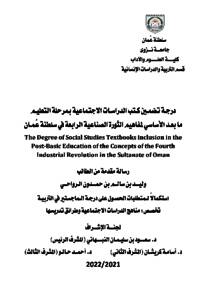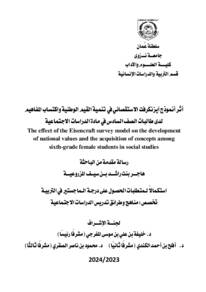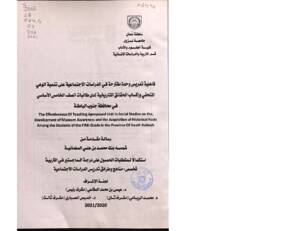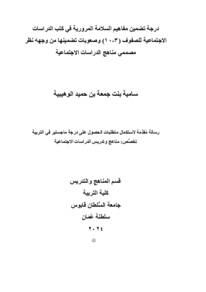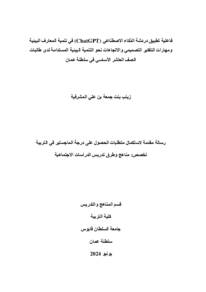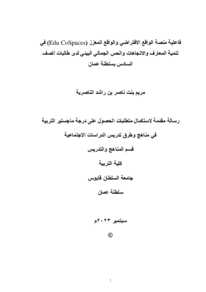وثيقة
درجـــة تضمــين كــتب الدراســـات الاجتمــاعيــة بمرحلــة التعليـــم مـا بعـــد الأساسـي لمفاهيـم الثـورة الصناعيـة الرابعـة فـي سلطنـة عمـان.
المعرف
الرواحي, وليد بن سالم (2022). درجـــة تضمــين كــتب الدراســـات الاجتمــاعيــة بمرحلــة التعليـــم مـا بعـــد الأساسـي لمفاهيـم الثـورة الصناعيـة الرابعـة فـي سلطنـة عمـان (رسالة ماجستير، جامعة نزوى، نزوى، عمان).
الناشر
جامعة نزوى.
ميلادي
2022
اللغة
العربية
الموضوع
الملخص الإنجليزي
This study aimed to investigate the degree of social studies textbooks inclusion of the concepts of the fourth industrial revolution in the post-basic education level in the Sultanate of Oman by analyzing their content and the perspective of their teachers. To achieve the study objectives and answer its questions, three research inventories were established. The first inventory is a list of the fourth industrial revolution's concepts that have to be included in the social studies textbooks. The final form of this inventory consisted of (32) concepts distributed to four main fields; i.e.: (Artificial Intelligence Field), (Education and Sustainability Field), (Knowledge Creativity and Finding Solutions Field), and (Interactive Social Relations Field); each field includes (8) concepts. The second inventory is a content analysis card that aimed to identify the degree of social studies textbooks inclusion of the concepts of the fourth industrial revolution in the post education level in the Sultanate of Oman by analyzing its scientific content. Therefore, the content analysis card included all concepts of the fourth industrial revolution included in the concepts' list in all of its four fields, which means that the card consisted of (32) concepts distributed to four fields; (8) concepts for each field. The third inventory is a questionary made by the researcher to address the degree of social studies textbooks inclusion of the concepts of the fourth industrial revolution in the post basic education level from the teachers' perspective. The final form of the questionary consisted of (32) phrases declarative phrases distributed to four fields; (8) phrases for each field. The fields of this inventory are the same fields of the concepts' list and the content analysis card. Each phrase has five (5) responses: (Very Big – Big – Moderate – Little – Very Little). Then, the researcher checked the psychometric properties of the study inventory with regard to their validity and reliability to get the inventories ready for application.
The study sample consisted of two categories. The first one is the study teachers' sample, as the study was applied to a random sample of (170) male and female teachers of social studies from the post basic education level which represent (44.4%) of the total community of social studies' teachers in this level. The second sample of the study represented by the subject of social studies in the post basic education which was applied to two books; i.e.: (Social Studies textbook(this my country) for Twelfth Grade) and (Economic Geography textbook for Eleventh Grade) which were selected using the simple random method. This sample represents (33.3%) of the total community size of social studies' textbooks for this level. The application of this study depended on the descriptive approach in form of survey. The study came up with the following conclusions:
- Concluding a list of the fourth industrial revolution's concepts that should be included in the social studies textbooks that consists of (32) concepts educationally and methodologically regulated considering opinions and remarks of educational and psychological experts and economic specialists and in light of the previous educational literature, researches and studies.
- The degree of the concepts of the fourth industrial revolution's inclusion in the economic geography textbook for the eleventh grade through analyzing the scientific content ranged between (very little) and (little), while the degree of its inclusion of the fourth industrial revolution's concepts was (big) from the teachers' perspective.
- The degree of the concepts of the fourth industrial revolution's inclusion in the social studies textbook for the twelfth grade through analyzing the scientific content ranged between (very little) and (little), while the degree of its inclusion of the fourth industrial revolution's concepts was (big) from the teachers' perspective.
- The degree of the concepts of the fourth industrial revolution's inclusion in both textbooks through analyzing their scientific content ranged between (very little) and (little), while the degree of its inclusion of the fourth industrial revolution's concepts was (big) from the teachers' perspective.
- There was not any contingency in the degree of the concepts of the fourth industrial revolution's inclusion in the economic geography textbook for the eleventh grade between the content analysis and teachers' perspective; which mean that the contingency degree is (totally absent).
- There was a contingency in the degree of the concepts of the fourth industrial revolution's inclusion in the social studies textbook for the twelfth grade between the content analysis and teachers' perspective with a contingency percentage of (25 %); which mean that the contingency degree was (low).
- There was not any contingency in the degree of the concepts of the fourth industrial revolution's inclusion in both books between the content analysis and teachers' perspective; which mean that the contingency degree is (totally absent).
In light of this study results, the researcher came up with several recommendations; the most important of which were the necessity of giving the proper care to the inclusion of the concepts of the fourth industrial revolution in the social studies textbooks in the post basic education level and working on preparing and executing training programs for teachers about employing the fourth industrial revolution's concepts in education.
المجموعة
URL المصدر
الملخص العربي
هدفت هذه الدراسة التعرف إلى درجة تضمين كتب الدراسات الاجتماعية بمرحلة التعليم ما بعد الأساسي في سلطنة عمان لمفاهيم الثورة الصناعية الرابعة من خلال تحليل محتواها ووجهة نظر معلميها، ولتحقيق أهداف الدراسة والإجابة عن أسئلتها تم بناء ثلاث أدوات بحثية، تمثلت الأولى في قائمة مفاهيم الثورة الصناعية الرابعة اللازم تضمينها في كتب الدراسات الاجتماعية، والتي تكونت في صورتها النهائية من (32) مفهوما موزعة على أربعة مجالات أساسية هي: (مجال الذكاء الاصطناعي) و (مجال التعليم والاستدامة) و (مجال إبداع المعرفة وإيجاد الحلول) و (مجال العلاقات الاجتماعية التفاعلية) بواقع (8) مفاهيم لكل مجال منها. أما الأداة الثانية فقد تمثلت في بطاقة تحليل المحتوى، والتي استهدفت التعرف إلى درجة تضمين كتب الدراسات الاجتماعية بمرحلة التعليم ما بعد الأساسي في سلطنة عمان لمفاهيم الثورة الصناعية الرابعة من خلال تحليل محتواها العلمي، حيث تضمنت بطاقة تحليل المحتوى على جميع مفاهيم الثورة الصناعية الرابعة التي اشتملت عليها قائمة المفاهيم في مجالاتها الأربعة، وهذا يعني أن البطاقة قد تكونت من (32 ) مفهوما موزعة على أربعة مجالات بواقع (8) مفاهيم لكل مجال. أما الأداة الثالثة فقد تمثلت في استبانة أعدها الباحث لمعرفة درجة تضمين كتب الدراسات الاجتماعية بمرحلة التعليم ما بعد الأساسي لمفاهيم الثورة الصناعية الرابعة من وجهة نظر المعلمين، حيث تكونت هذه الاستبانة في صورتها النهائية من (32) عبارة تقريرية موزعة على أربعة مجالات بواقع (8) عبارات لكل مجال منها، وهي ذاتها المجالات الأربعة التي تكونت منها قائمة المفاهيم وبطاقة تحليل المحتوى، يقابل كل عبارة منها (5) خمس استجابات هي: (كبيرة جدا – كبيرة – متوسطة – قليلة – قليلة جدا). ثم قام الباحث بالتحقق من الخصائص السيكومترية لأدوات الدراسة، من حيث: صدقها وثباتها، لتصبح الأدوات جاهزة للتطبيق.
وقد تكونت عينة الدراسة من فئتين هما: عينة الدراسة من المعلمين، حيث تم تطبيق الدراسة على عينة عشوائية بلغ حجمها (170) معلما ومعلمة من معلمي الدراسات الاجتماعية بمرحلة التعليم ما بعد الأساسي، بنسبة بلغت (44.4 %) من حجم المجتمع الكلي لمعلمي الدراسات الاجتماعية بهذه المرحلة. أما عينة الدراسة الثانية فقد تمثلت في الكتب الدراسية لمادة الدراسات الاجتماعية بمرحلة التعليم ما بعد الاساسي، وتم تطبيقها على كتابين هما: (كتاب الدراسات الاجتماعية (هذا وطني) للصف الثاني عشر) و (كتاب الجغرافيا الاقتصادية للصف الحادي عشر) تم اختيارهما وفق الطريقة العشوائية البسيطة، بنسبة بلغت (33.3 %) من إجمالي حجم المجتمع الكلي من كتب الدراسات الاجتماعية في هذه المرحلة، وقد تم تنفيذ الدراسة اعتمادا على المنهج الوصفي في صورته المسحية، وخلصت الدراسة إلى النتائج الآتية:
- ظهور قائمة بمفاهيم الثورة الصناعية الرابعة اللازم تضمينها في كتب الدراسات الاجتماعية، مكونة من (32) مفهوما مقننة تربويا ومنهجيا، وذلك في ضوء آراء وملاحظات الخبراء التربويين والنفسيين، والمختصين الاقتصاديين، وفي ضوء نتائج الأبحاث والدراسات والأدبيات التربوية السابقة.
- تراوحت درجة تضمين كتاب الجغرافيا الاقتصادية للصف الحادي عشر لمفاهيم الثورة الصناعية الرابعة من خلال تحليل محتواه العلمي بين: (القليلة جداً) و(القليلة)، في حين كانت درجة تضمينه لمفاهيم الثورة الصناعية الرابعة من خلال وجهة نظر معلميه (كبيرة).
- تراوحت درجة تضمين كتاب الدراسات الاجتماعية للصف الثاني عشر لمفاهيم الثورة الصناعية الرابعة من خلال تحليل محتواه العلمي بين: (القليلة جداً) و(القليلة)، في حين كانت درجة تضمينه لمفاهيم الثورة الصناعية الرابعة من خلال وجهة نظر معلميه (كبيرة).
- تراوحت درجة تضمين كتابي الدراسات الاجتماعية معا لمفاهيم الثورة الصناعية الرابعة من خلال تحليل محتوهما العلمي بين: (القليلة جداً) و(القليلة)، في حين كانت درجة تضمينهما لمفاهيم الثورة الصناعية الرابعة من خلال وجهة نظر معلميهما (كبيرة).
- عدم وجود توافق في درجة تضمين كتاب الجغرافيا الاقتصادية للصف الحادي عشر لمفاهيم الثورة الصناعية الرابعة بين تحليل محتواه ووجهة نظر معلميه، وهذا يعني أن درجة التوافق (منعدمة).
- وجود توافق في درجة تضمين كتاب هذا الدراسات الاجتماعية للصف الثاني عشر لمفاهيم الثورة الصناعية الرابعة بين تحليل محتواه ووجهة نظر معلميه، بنسبة توافق بلغت (25 %) وبدرجة توافق كانت (منخفضة).
- عدم وجود توافق في درجة تضمين الكتابين معا لمفاهيم الثورة الصناعية الرابعة بين تحليل محتواهما ووجهة نظر معلميهما، وهذا يعني أن درجة التوافق كانت (منعدمة).
وفي ضوء نتائج الدراسة توصل الباحث إلى مجموعة من التوصيات كان من أهمها ضرورة الاهتمام بتضمين مفاهيم الثورة الصناعية الرابعة في كتب الدراسات الاجتماعية بمرحلة التعليم ما بعد الأساسي، والعمل على إعداد وتنفيذ برامج تدريبية للمعلمين حول توظيف مفاهيم الثورة الصناعية الرابعة في التعليم.
وقد تكونت عينة الدراسة من فئتين هما: عينة الدراسة من المعلمين، حيث تم تطبيق الدراسة على عينة عشوائية بلغ حجمها (170) معلما ومعلمة من معلمي الدراسات الاجتماعية بمرحلة التعليم ما بعد الأساسي، بنسبة بلغت (44.4 %) من حجم المجتمع الكلي لمعلمي الدراسات الاجتماعية بهذه المرحلة. أما عينة الدراسة الثانية فقد تمثلت في الكتب الدراسية لمادة الدراسات الاجتماعية بمرحلة التعليم ما بعد الاساسي، وتم تطبيقها على كتابين هما: (كتاب الدراسات الاجتماعية (هذا وطني) للصف الثاني عشر) و (كتاب الجغرافيا الاقتصادية للصف الحادي عشر) تم اختيارهما وفق الطريقة العشوائية البسيطة، بنسبة بلغت (33.3 %) من إجمالي حجم المجتمع الكلي من كتب الدراسات الاجتماعية في هذه المرحلة، وقد تم تنفيذ الدراسة اعتمادا على المنهج الوصفي في صورته المسحية، وخلصت الدراسة إلى النتائج الآتية:
- ظهور قائمة بمفاهيم الثورة الصناعية الرابعة اللازم تضمينها في كتب الدراسات الاجتماعية، مكونة من (32) مفهوما مقننة تربويا ومنهجيا، وذلك في ضوء آراء وملاحظات الخبراء التربويين والنفسيين، والمختصين الاقتصاديين، وفي ضوء نتائج الأبحاث والدراسات والأدبيات التربوية السابقة.
- تراوحت درجة تضمين كتاب الجغرافيا الاقتصادية للصف الحادي عشر لمفاهيم الثورة الصناعية الرابعة من خلال تحليل محتواه العلمي بين: (القليلة جداً) و(القليلة)، في حين كانت درجة تضمينه لمفاهيم الثورة الصناعية الرابعة من خلال وجهة نظر معلميه (كبيرة).
- تراوحت درجة تضمين كتاب الدراسات الاجتماعية للصف الثاني عشر لمفاهيم الثورة الصناعية الرابعة من خلال تحليل محتواه العلمي بين: (القليلة جداً) و(القليلة)، في حين كانت درجة تضمينه لمفاهيم الثورة الصناعية الرابعة من خلال وجهة نظر معلميه (كبيرة).
- تراوحت درجة تضمين كتابي الدراسات الاجتماعية معا لمفاهيم الثورة الصناعية الرابعة من خلال تحليل محتوهما العلمي بين: (القليلة جداً) و(القليلة)، في حين كانت درجة تضمينهما لمفاهيم الثورة الصناعية الرابعة من خلال وجهة نظر معلميهما (كبيرة).
- عدم وجود توافق في درجة تضمين كتاب الجغرافيا الاقتصادية للصف الحادي عشر لمفاهيم الثورة الصناعية الرابعة بين تحليل محتواه ووجهة نظر معلميه، وهذا يعني أن درجة التوافق (منعدمة).
- وجود توافق في درجة تضمين كتاب هذا الدراسات الاجتماعية للصف الثاني عشر لمفاهيم الثورة الصناعية الرابعة بين تحليل محتواه ووجهة نظر معلميه، بنسبة توافق بلغت (25 %) وبدرجة توافق كانت (منخفضة).
- عدم وجود توافق في درجة تضمين الكتابين معا لمفاهيم الثورة الصناعية الرابعة بين تحليل محتواهما ووجهة نظر معلميهما، وهذا يعني أن درجة التوافق كانت (منعدمة).
وفي ضوء نتائج الدراسة توصل الباحث إلى مجموعة من التوصيات كان من أهمها ضرورة الاهتمام بتضمين مفاهيم الثورة الصناعية الرابعة في كتب الدراسات الاجتماعية بمرحلة التعليم ما بعد الأساسي، والعمل على إعداد وتنفيذ برامج تدريبية للمعلمين حول توظيف مفاهيم الثورة الصناعية الرابعة في التعليم.
قالب العنصر
الرسائل والأطروحات الجامعية

